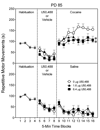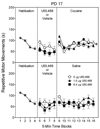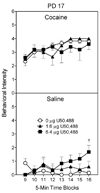Age-dependent effects of kappa-opioid receptor stimulation on cocaine-induced stereotyped behaviors and dopamine overflow in the caudate-putamen: an in vivo microdialysis study
- PMID: 20435099
- PMCID: PMC2900406
- DOI: 10.1016/j.neuroscience.2010.04.052
Age-dependent effects of kappa-opioid receptor stimulation on cocaine-induced stereotyped behaviors and dopamine overflow in the caudate-putamen: an in vivo microdialysis study
Abstract
kappa-Opioid receptor stimulation attenuates psychostimulant-induced increases in extracellular dopamine in the caudate-putamen (CPu) and nucleus accumbens of adult rats, while reducing cocaine-induced locomotor activity and stereotyped behaviors. Because kappa-opioid receptor agonists (e.g., U50,488 or U69,593) often affect the behavior of preweanling rats in a paradoxical manner, the purpose of the present study was to determine whether kappa-opioid receptor stimulation differentially affects dopaminergic functioning in the CPu depending on age. In vivo microdialysis was used to determine whether U50,488 (5 mg/kg) attenuates cocaine-induced dopamine overflow in the dorsal CPu on postnatal day (PD) 17 and PD 85. In the microinjection experiment, cocaine-induced stereotyped behaviors were assessed in adult and preweanling rats after bilateral infusions of vehicle or U50,488 (1.6 or 6.4 microg per side) into the CPu. Results showed that U50,488 attenuated the cocaine-induced increases in CPu dopamine overflow on PD 85, while the same dose of U50,488 did not alter dopamine dialysate levels on PD 17. Cocaine also increased stereotyped behaviors (repetitive motor movements, behavioral intensity scores, and discrete behaviors) at both ages, but adult rats appeared to exhibit more intense stereotypic responses than the younger animals. Consistent with the microdialysis findings, bilateral infusions of U50,488 into the dorsal CPu decreased the cocaine-induced stereotypies of adult rats, while leaving the behaviors of preweanling rats unaffected. These results suggest that the neural mechanisms underlying kappa-opioid/dopamine interactions in the CPu are not fully mature during the preweanling period. This lack of functional maturity may explain why kappa-opioid receptor agonists frequently induce different behavioral effects in young and adult rats.
Copyright (c) 2010 IBRO. Published by Elsevier Ltd. All rights reserved.
Figures







Similar articles
-
Importance of D1 and D2 receptors in the dorsal caudate-putamen for the locomotor activity and stereotyped behaviors of preweanling rats.Neuroscience. 2011 Jun 2;183:121-33. doi: 10.1016/j.neuroscience.2011.03.037. Epub 2011 Apr 2. Neuroscience. 2011. PMID: 21443930 Free PMC article.
-
Increased responsiveness of mesolimbic and mesostriatal dopamine neurons to cocaine following repeated administration of a selective kappa-opioid receptor agonist.Synapse. 1998 Nov;30(3):255-62. doi: 10.1002/(SICI)1098-2396(199811)30:3<255::AID-SYN3>3.0.CO;2-A. Synapse. 1998. PMID: 9776129
-
Behavioral effects of dopamine receptor inactivation in the caudate-putamen of preweanling rats: role of the D2 receptor.Psychopharmacology (Berl). 2014 Feb;231(4):651-62. doi: 10.1007/s00213-013-3280-9. Epub 2013 Sep 22. Psychopharmacology (Berl). 2014. PMID: 24057816 Free PMC article.
-
Effects of dorsal striatal infusions of R(-)-propylnorapomorphine on kappa-opioid-mediated locomotor activity in the young rat: possible role of the indirect pathway.Neuroscience. 2008 Aug 26;155(3):603-12. doi: 10.1016/j.neuroscience.2008.06.019. Epub 2008 Jun 14. Neuroscience. 2008. PMID: 18616989 Free PMC article.
-
Comparison of cocaine- and methamphetamine-evoked dopamine and glutamate overflow in somatodendritic and terminal field regions of the rat brain during acute, chronic, and early withdrawal conditions.Ann N Y Acad Sci. 2001 Jun;937:93-120. doi: 10.1111/j.1749-6632.2001.tb03560.x. Ann N Y Acad Sci. 2001. PMID: 11458542 Review.
Cited by
-
Repeated aripiprazole treatment causes dopamine D2 receptor up-regulation and dopamine supersensitivity in young rats.J Psychopharmacol. 2014 Apr;28(4):376-86. doi: 10.1177/0269881113504016. Epub 2013 Sep 17. J Psychopharmacol. 2014. PMID: 24045880 Free PMC article.
-
Importance of D1 and D2 receptors in the dorsal caudate-putamen for the locomotor activity and stereotyped behaviors of preweanling rats.Neuroscience. 2011 Jun 2;183:121-33. doi: 10.1016/j.neuroscience.2011.03.037. Epub 2011 Apr 2. Neuroscience. 2011. PMID: 21443930 Free PMC article.
-
Pharmacological activation of kappa opioid receptors: aversive effects in adolescent and adult male rats.Psychopharmacology (Berl). 2014 Apr;231(8):1687-93. doi: 10.1007/s00213-013-3095-8. Epub 2013 Apr 19. Psychopharmacology (Berl). 2014. PMID: 23604334 Free PMC article.
-
Adolescent forced swim stress increases social anxiety-like behaviors and alters kappa opioid receptor function in the basolateral amygdala of male rats.Prog Neuropsychopharmacol Biol Psychiatry. 2020 Mar 2;98:109812. doi: 10.1016/j.pnpbp.2019.109812. Epub 2019 Nov 7. Prog Neuropsychopharmacol Biol Psychiatry. 2020. PMID: 31707090 Free PMC article.
-
Kappa Opioid Receptor-Mediated Disruption of Novel Object Recognition: Relevance for Psychostimulant Treatment.J Addict Res Ther. 2011;S4:007. doi: 10.4172/2155-6105.S4-007. Epub 2011 Dec 24. J Addict Res Ther. 2011. PMID: 22900234 Free PMC article.
References
-
- Abrams DR, Bruno JP. Ontogeny of apomorphine-induced stereotypy and its D1 and D2 receptor mediation in rats depleted of dopamine as neonates. Dev Psychobiol. 1992;25:475–495. - PubMed
-
- Adachi YU, Yamada S, Satomoto M, Higuchi H, Watanabe K, Kazama T. Isoflurane anesthesia induces biphasic effect on dopamine release in the rat striatum. Brain Res Bull. 2005;67:176–181. - PubMed
-
- Alexander GE, DeLong MR, Strick PL. Parallel organization of functionally segregated circuits linking basal ganglia and cortex. Ann Rev Neurosci. 1986;9:357–381. - PubMed
-
- Bolanos CA, Garmsen GM, Clair MA, McDougall SA. Effects of the κ-opioid receptor agonist U-50,488 on morphine-induced place preference conditioning in the developing rat. Eur J Pharmacol. 1996;317:1–8. - PubMed
Publication types
MeSH terms
Substances
Grants and funding
LinkOut - more resources
Full Text Sources
Medical

